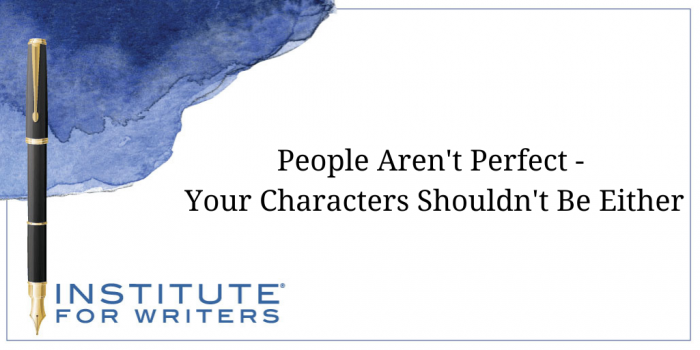1000 N. West Street #1200, Wilmington, DE 19801
© 2024 Direct Learning Systems, Inc. All rights reserved.

Characters are the foundation of your story. The bricks in the walls.
Bricks are made from a mold. They’re similar, but not exactly alike, and none of them are perfect. You can see the imperfections if you look closely enough. That’s what draws your attention, the imperfections.
It’s the same with your characters.
The imperfections in bricks are the result of how the ingredients are mixed and how the bricks are fired. The firing gives bricks their strength. Life experiences give your characters strength. Other ingredients are physical appearance and personality traits. Your job as the author is to mix those ingredients carefully and thoughtfully to create unique and interesting-to-the-reader characters.
If creating sympathetic and believable characters is a challenge for you, here are some examples of archetypes—or molds—you can follow:
The Bully
The Dreamer
The Evil Genius
The Hero
The Mentor
The Sidekick
The Martyr
The Outcast
The Survivor
The Temptress
The Tyrant
The Wizard
The Bully, the Evil Genius, the Tyrant, and maybe the Wizard, are good molds to cast a villain. The Mentor or the Sidekick are basic models for secondary characters. Obviously, the Hero—or Heroine, if the character is female—is your protagonist. But the Outcast, the Dreamer, or even the Survivor could be interesting choices for a main character.
You will get the hang of characterization, trust me. Once you do, play around with archetypes. Try combining a couple to create a hybrid. See if you can turn the Bully or the Tyrant into a protagonist, or into a Mentor or a Dreamer. Mixing things up is a firecracker for creativity.
Another mold you can create is the character worksheet. See if you can define the role that each character plays in your story.
On your character worksheet, fill in details of physical description, life experience and personality for each character. Every character? Really, you ask, feeling faint. Minor characters, no, I wouldn’t bother, but yes for protagonists and secondary characters. Fill out the things you don’t know about your characters such as:

Favorite color:
Favorite toy, game, or sport:
Favorite season of the year:
Things they find boring:
Things they find scary:
Worst memory:
Best memory:
Wow, you may be thinking, and perhaps feeling faint again, that’s a lot of detail. Yes, it is, and you’ll need every bit of it as you write the story, especially if you’re writing a novel, so suck it up and fill in the blanks.
Do I use character worksheets? Absolutely. I wouldn’t start a novel without one for my main and secondary characters. Compiling character worksheets has given me some great ideas for my stories. Seriously. You’ll be surprised by what your subconscious will throw at you when you’re dreaming up characters.
Since I mentioned the subconscious, let me digress to tell you that in my opinion there’s no such thing as writer’s block. What happens when you hit a wall is this—you zigged someplace where you should’ve zagged. Your subconscious, where all your creativity resides, recognizes this and stops you cold. It does this because your conscious mind is such a blabbermouth your subconscious can’t get a word in edgewise. Go back, reread, you’ll find the goof. Once you fix it, you’ll be able to move on.
One thing I include on my worksheets is birth info, date and year. That’s another mold you can use to create characters, Zodiac signs. For instance, I’m a Libra. We’re great starters, but so-so finishers. We’re also basically lazy, which is why I love deadlines. What if I were a character? What would those traits lead to? Wherein does the conflict lie?
Once you’ve complied all this information and juicy detail, what are you supposed to do with it? Use it to create sympathetic, meaning likeable, characters that readers can relate to and believe in. Believing in your characters is vital to the success of your story. We’ll cover that in part four.
The money word in that paragraph is relate, which means feel sympathy with, identify with, and establish a connection between. In fiction, you’re striving for an emotional connection between readers and your characters. That’s why perfect doesn’t cut it. Can you relate to perfect? I can’t. We’re all a mess of some sort or another.
Here’s an example of relatability using physical appearance.
Let’s say that I, your reader, think my nose resembles a ski jump. Then let’s say your character Evelyn thinks her long, skinny feet look like a pair of cross-country skis. If she says, “Only Olive Oyl could love my feet,” I can relate to that. But if Henry, the boy who falls in love with Evelyn, says her feet are sexy, that changes Evelyn’s perception of her feet.
Your main characters should be likeable because you want readers cheering them on to reach their goals. If I, your reader, don’t like your characters, if you fail to connect me to them emotionally, I won’t care two figs what happens to them—and I’ll stop reading. That’s the last thing any writer wants.
Likeable doesn’t mean a Goody Two Shoes. It means human and imperfect, just like us real folk. Yet be mindful of unsympathetic behaviors such as too many tears, playing the victim, pity parties, whining, and complaining. Yes, we all throw tantrums now and then, but on the page bad behavior can be a real turn off for readers.
Here’s what Mark Twain says about sympathetic characters:
“The author shall make the reader feel a deep interest in the personages of his tale and in their fate; and he shall make the reader love the good people in the tale and hate the bad ones.”
As the old saying goes, the devil is in the details, especially when it comes to your characters. Next time, we’ll discuss life experiences, which is the forge for your characters.
Lynne Smith, aka Lynn Michaels, is the author of 2 novellas and 16 novels, 3 of which were nominated for the Romance Writers of America’s RITA award, the Oscar of romance writing. She won 2 awards from Romantic Times Magazine, for best romantic suspense and best contemporary romance. Her only complaint about writing is that it really cuts into her reading time. She lives in Missouri with her husband, two sons, 3 grandsons and one granddaughter, born on Lynne’s birthday. Lynne is also an IFW instructor. She teaches “Breaking into Print” and “Shape, Write and Sell Your Novel”.
1000 N. West Street #1200, Wilmington, DE 19801
© 2024 Direct Learning Systems, Inc. All rights reserved.
1000 N. West Street #1200, Wilmington, DE 19801
© 2024 Direct Learning Systems, Inc. All rights reserved.
1000 N. West Street #1200, Wilmington, DE 19801
© 2024 Direct Learning Systems, Inc. All rights reserved.
1000 N. West Street #1200, Wilmington, DE 19801
© 2024 Direct Learning Systems, Inc. All rights reserved.

1000 N. West Street #1200, Wilmington, DE 19801
© 2025 Direct Learning Systems, Inc. All rights reserved.

1000 N. West Street #1200, Wilmington, DE 19801
©2025 Direct Learning Systems, Inc. All rights reserved. Privacy Policy.